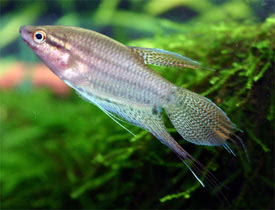
 Magyarul / Hungarian
Magyarul / Hungarian


- Scientific name: Trichopsis vittata
- Common name: Croaking gourami
- Group: Labyrinth fishes
- Habitat: Asia; Thailand, Vietnam, Malaysia, Indonesia.
- Size: 6-7 cm
- Biotope: Inhabits small ponds, canals, creeks, and lakes in Southeast Asia
- Social behavior: A timid, peaceful species that can be combined with other small, calm fish. Males are occasionally aggressive in defending their territory at spawning times.
- Diet: Live, insect larvae, Drosophila, crustaceans, Tubifex, flakes
- Breeding: Breeding is difficult.
- Tank: Minimum 80 litres
- Population: 4 fish for 100 litres.
- Decoration: The tank should be heavily planted And include a cover of floating plants. Provide hiding places among rocks and wood, and use a dark substrate.
- Temperature: 26-28°C
- pH : 5,5-8.
- Hardness: 2,8-5,6 NK°
- Lifespan: 5 years
Description: An elongated, laterally compressed fish with pointed anal, dorsal, and caudal fins. The back is dark beige, while the flanks are light beige to off-white. The flanks are marked with three transverse stripes that are brown to red in color. These run from the snout, parallel to one another, to the caudal fin. A spot, blue or black in color, is located near the gill cover. The rear half of the body may have a green iridescence. The fins range from blue-green to violet in color with overlaying red stripes and spots. These fins have a blue and red edging. The iris of the eye is blue.
The male builds a bubble nest under a large leaf. This nest is small and inconspicuous. During spawning, when the fish embrace, croaking noises can be heard. Requires a water temperature from 84-88°F (29-31°C), a water hardness from 1-4°dH, and a low water level of 3-6" (8-15 cm). Up to 240 eggs are laid and deposited in the bubble nest.
These are guarded by the male. Remove the female at this point. The eggs hatch after 44-48 hours. The fry remain in the nest for two additional eggs. Start feeding with infusoria and roftiers.


